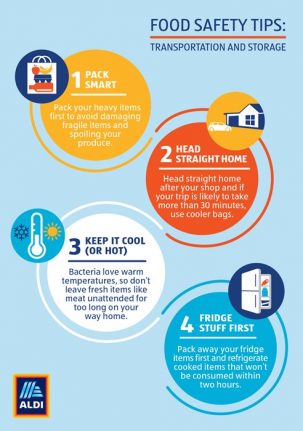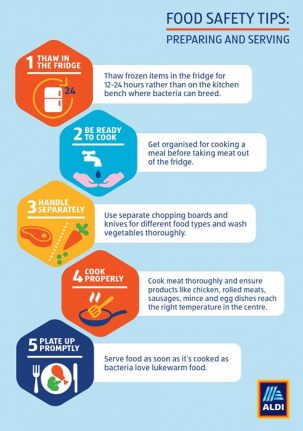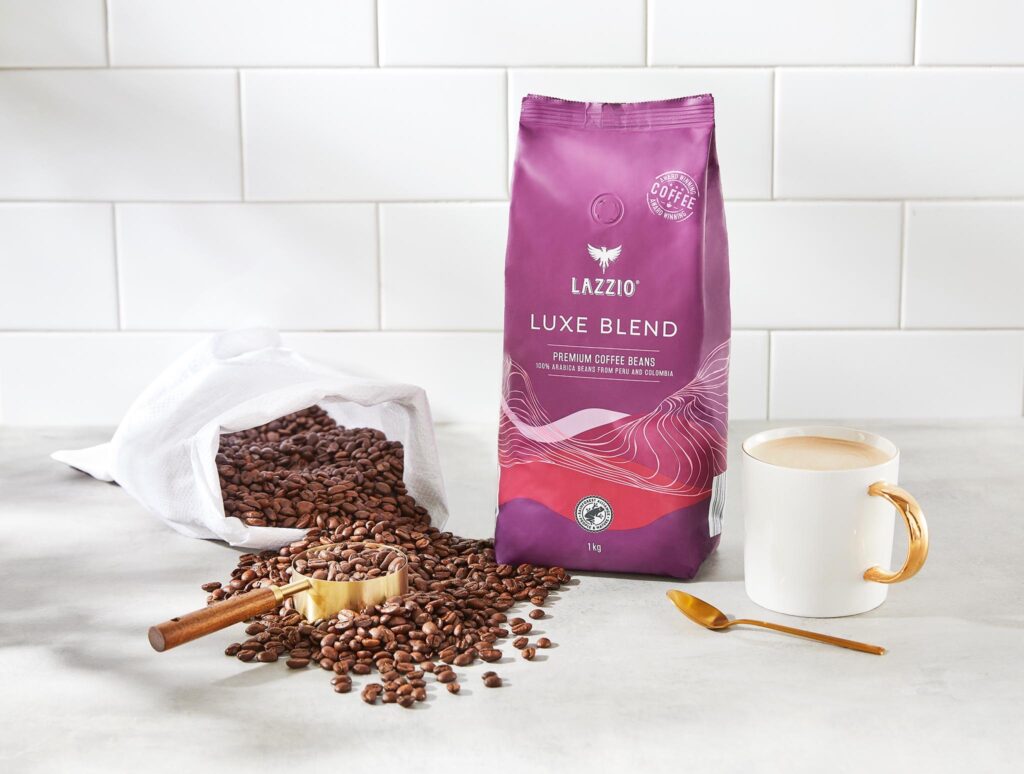Summer brings more than barbeques, holidays and lazy days in the sun. Harmful bacteria like Salmonella and Campylobacter thrive in warmer temperatures, which is why cases of food poisoning spike at this time of year. According to the Food Safety Information Council*, there are an estimated 4.1 million cases of food poisoning in Australia each year resulting in 1 million visits to the doctor and over 30,000 hospital admissions. The improper handling, storage and preparation in the kitchen accounts for a large majority of food-related incidents including food poisoning and larvae.
ALDI’S APPROACH TO FOOD SAFETY
ALDI takes food safety very seriously. Our supplier agreements mandate adherence to certified food safety systems that are in line with the Global Food Safety Initiative (GFSI). One of the requirements of these systems is adequate temperature control. At several points during the production cycle, the temperature is recorded and checked against the relevant provisions. And temperature control doesn’t stop at the point of production. At every point in the supply chain, from the time a product leaves a supplier’s facility to the time a consumer picks up the product in store, we ensure that it is kept at the correct temperature.
FOOD SAFETY FAQs
Let’s get straight to the point – there are many do’s and don’ts when it comes to preparing food. Our Quality Assurance experts lay to rest some common questions our shoppers ask, while also busting a myth or two (yes, you do need to wash your vegetables).
Q. What pantry foods are most susceptible to moth infestations?
A. All dry, shelf-stable (ambient) products such as flour, oats, crackers and biscuits.
Q. How can I avoid a pantry moth infestation?
A. Keep your pantry clean and seal all packaging well. Open packaging will attract moths.
Q. Should I wash all my fruit and vegetables?
A. Yes. Even though ALDI produce is washed prior to arriving in store, you should wash it again before consumption. This will help ensure the produce is free of pathogens and any germs from other customers. You should be particuarly thorough with things like lettuce and spinach whose leaves can trap unwanted dirt and germs.
Q. What are some warning signs to look out for in my fridge?
A. If any products in your fridge match the below descriptions, we advise disposing of the product.
- Meat: Discoloured, dry, bad smell.
- Produce: Limp, mouldy, wrinkly and/or featuring wet patches.
- Milk and cream: Lumpy consistency, sour taste or smell.
- Ready-made meals: Dry, wrinkly, mouldy.
Q. Should I refrigerate cooked foods immediately or wait until they cool?
A. You should wait for hot foods to cool down before placing them in the fridge. Failure to do so will lead to condensation forming in the container, which will promote the growth of harmful bacteria. Hot food will also cause the temperature in the fridge to rise, which could compromise other food items.
Q. I’m having an outdoor barbeque. What do I need to consider for my buffet-style spread?
A. Firstly, foods should be served on separate plates to avoid cross contamination. You’ll also want to provide plenty of serving utensils so that people aren’t tempted to use their hands. And you should keep everything covered up until it’s time to eat.
Q. I just had a barbeque and left a tray of sausages and a potato bake outside for a couple of hours. Can I refrigerate them to eat later on, or should I throw them out?
A. Cooked food should be stored at a temperature of around 4˚C within two hours. On particularly hot days, cooked foods should be refrigerated within one hour.
WHAT TO DO TO AVOID FOOD POISONING
Now, let’s get down to the nitty gritty of how nasty food-related incidents can be avoided in the first place.


THE RISKS
If the topic of food safety so far has you worried, hearing about the risks will ensure you stay cautious when it comes to cooking safely this summer. There’s actually some pretty serious consequences including:
- Harmful bacteria
Salmonella causes a nasty type of gastroenteritis. It’s contracted by transferring the bacteria from contaminated food or surfaces to your mouth. The symptoms range from fever to diarrhoea and vomiting, and can last from two to seven days. The best treatment is drinking lots of water, however children, pregnant women and the elderly may be prescribed a course of antibiotics. Of course, prevention is always better than cure, so take care cooking high risk foods such as chicken and eggs by remembering to use clean chopping boards, plates, utensils and containers for each food product you are preparing.
“Most people have heard of Salmonella but many don’t know about Campylobacter and it is responsible for a lot of food poisoning in Australia,” says Rachelle Williams from the Food Safety Information Council.
Campylobacter is another harmful bacteria that leads to ‘gastro.’ It’s commonly found in raw and undercooked poultry and contaminated water. The symptoms include diarrhoea, fever and stomach cramps; vomiting is less common. Drinking plenty of water will help with dehydration and the symptoms usually pass within a few days. That said, a person can be infectious for two to three weeks after the symptoms subside, so extra vigilance on the personal hygiene front is recommended.
- Pests and bugs
Many of the foods that we eat make great homes for creatures we really don’t want anywhere near our food. Very occasionally, these pests and bugs, such as maggots and various bugs, appear on or in food products that otherwise appear to be fine. With fruit and vegetables grown on open farmland, contamination is not unheard of. So, it’s always a good idea to wash your fruit and veg thoroughly before eating.
Other pests and bugs, such as insect larvae (the juvenile form of an insect), can thrive in or on meat products. Given that fly larvae, for example, can only survive between 10 and 40 degrees Celsius—that is, not in the fridge and not while being cooked—it’s never a good idea to leave meat unattended on the kitchen bench on a hot day. Fly eggs can hatch within minutes of being laid on a nice piece of meat!
Fresh produce and meat aren’t the only foods that attract bugs. The Indian Meal Moth will move in to your pantry in a heartbeat given half the chance. Able to infiltrate even well sealed packaging, this little moth can infest a wide range of dry foodstuffs, from cereals to nuts and biscuits. Weevils, meanwhile, are sometimes found in flour, cornmeal and cereal. While moths and weevils are both pretty gross, the good news is that they’re not harmful to humans. Still, once you store dry foods in your pantry, you might want to check for silk deposits (moths) and large holes in grains (weevils) just to be sure.
If you do find an infestation in one of your pantry items, dispose of the product and locate the source of the problem. Once the offending products have been disposed of, vacuum your pantry inside and out, and give the shelves a good clean. To avoid further outbreaks, make sure you store your food in clean, air tight containers and don’t forget to keep the lids shut tight.
- Mould
Let’s get one thing straight, while mould can be risky, it isn’t always a dangerous thing. Mould is a fungi that typically accumulates in damp places that can grow on certain food products. Question is: is it safe to simply cut off mouldy bits on food and eat the rest? In short, it depends. Some moulds produce mycotoxins, which are poisonous and potentially harmful if ingested. And these mycotoxins aren’t visible. For example, wet and porous foods such as casseroles and breads could well harbour harmful organisms that are invisible to the naked eye. In other words, scooping the mould out of a casserole and eating the rest isn’t recommended. However, with dense foods, like hard cheese and carrots, it typically possible to cut off the mouldy section and eat the rest without ingesting potentially harmful mycotoxins.
When it comes to avoiding mould, keep food stuffs covered to avoid contamination from air borne spores; clean your fridge regularly, and make sure your tea towels are squeaky clean.
STAYING SAFE THIS SUMMER
While it’s essential to always be on your hygiene A-game when it comes to transporting, storing and preparing food, it’s important to be especially vigilant in the warmer months. Follow our lead and you should avoid any food-related nasties this summer.
*The Food Safety Information Council is a health promotion charity and the national voice for science-based, consumer-focused food safety information in Australia. For more food safety tips, visit www.foodsafety.asn.au





